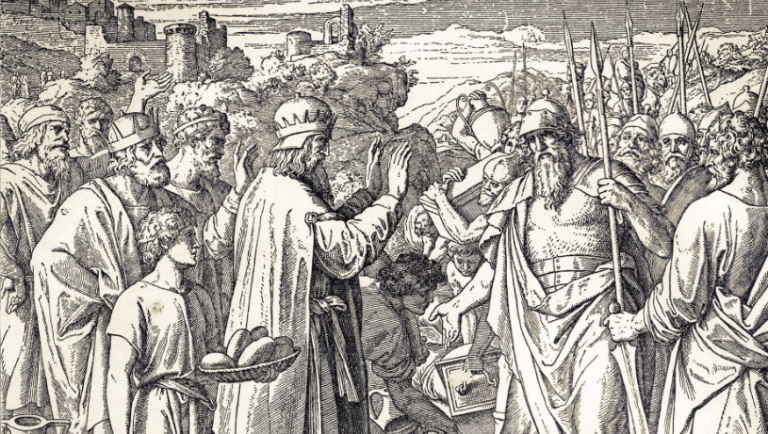Jesus Ever Lives Above, Interceding for You

Jesus intercedes for believers. This is a classic aspect of Christian theology, yet it’s often overlooked. Intercessory prayer was part of Christ’s ministry during his time on earth (John 17, Luke 22:32), and the Scriptures teach that he now intercedes for us from his exalted position on the throne in heaven (Romans 8:34, Hebrews 7:25, 1 John 2:1). But what does this really mean, and how does it impact our daily lives?
To gain a better understanding of Christ’s intercession and its practical implications, I had a conversation with D.A. Carson, co – founder and president of The Gospel Coalition and research professor of New Testament at Trinity Evangelical Divinity School.
What is Christ’s Intercession, and Where is it Most Clearly Taught in the Bible?
Christ’s intercessory ministry is most explicitly described in Hebrews 7:25. Based on his once – for – all sacrifice on the cross and his eternal resurrection life, Christ lives forever to intercede for us. This is often referred to as his high – priestly ministry. While the relevant themes are perhaps most strongly emphasized in Hebrews, other passages also come to mind. For instance, John 17 is often called Jesus’ “high – priestly prayer,” although John doesn’t explicitly label it as such. In this chapter, Jesus is clearly praying for his people, which means he’s engaged in intercession.
We can think of Jesus’ high – priestly ministry in a broad sense. We can start by looking at the examples from the Old Testament. The Old Testament high priest, on the Day of Atonement, had to take the blood of a bull and a goat into the most holy place and sprinkle it on the Ark of the Covenant. As our high priest, Christ brings his own blood into the presence of the heavenly tabernacle. However, the teachings in the Bible are complex and intertwined. Jesus isn’t just the high priest; he’s also the sacrificial Passover lamb, the Davidic king, the true temple, the true Israel, and more.
In the Old Testament, these roles were distinct (even though they were related), but in the New Testament, they often come together and point to Jesus. This means that the relationship between the Old Testament types and the New Testament fulfillment isn’t always straightforward. For example, Jesus is the true tabernacle (John 1:14), the true temple (John 2), the true priest, and the true sacrifice. These images can be understood in different ways: in Hebrews, he takes his blood into the heavenly temple to present it to God, where he’s the high priest but not the temple. Jesus is all of these roles – high priest, sacrifice, temple, and king – but the way they fit together varies. So, talking about Jesus’ high – priestly ministry involves many Old and New Testament themes, mostly centered around the cross.
When we focus on Jesus’ intercession as our high priest, the themes become more specific. However, we should distinguish between Jesus’ prayers for his people before the cross, which were related to his upcoming atonement, and what Hebrews 7:25 refers to, which is Jesus’ intercession for all his people after the cross. This later aspect is what I’ll focus on in the rest of my discussion.
How Does Christ’s Intercession Relate to His Atoning Work on the Cross?
In the context of Hebrews 7:25, Christ’s intercession is shown to occur after the cross. Christ’s sacrifice on the cross is a one – time event; it doesn’t need to be repeated like the annual sacrifices on Yom Kippur. Also, unlike the Old Testament high priests, Jesus has an eternal high – priesthood. He lives forever, and death can’t end his role. His priesthood is superior because it’s in the line of Melchizedek, not Aaron. He is “holy, blameless, pure, set apart from sinners, exalted above the heavens” (7:26), so he doesn’t need to offer sacrifices for his own sins before offering them for others (7:27).
For all these reasons, “he is able to save completely those who come to God through him” (7:25), precisely “because he always lives to intercede for them” (7:25). In other words, the complete salvation of his people depends on the effectiveness of his ongoing intercession, and the effectiveness of his intercession depends on his once – for – all sacrifice and his eternal life.
The words of Charles Wesley’s “Arise, My Soul Arise” remind us that there’s an even closer connection between Jesus’ death and his intercession. While we might want to adjust the words in the second stanza a bit, the third stanza shows the connection I’m talking about:
“Arise, my soul, arise! Shake off thy guilty fears;
The bleeding Sacrifice in my behalf appears.
Before the throne my Surety stands;
My name is written on his hands.
He ever lives above, for me to intercede,
His all – redeeming love, his precious blood to plead.
His blood atoned for all our race,
And sprinkles now the throne of grace.
Five bleeding wounds he bears, received on Calvary;
They pour effectual prayers, they strongly plead for me:
‘Forgive him, oh, forgive!’ they cry,
‘Nor let that ransomed sinner die.’”
What is the Content of Christ’s Intercession (What Does He Actually Say)? What is Its Result (What Does It Actually Do)?
In Wesley’s imaginative description of Jesus’ intercession in the stanza above, Jesus continuously prays for his people. He asks God to keep forgiving them, based on the fact that his sacrificial death has fully met God’s requirements. The next stanza makes this clear:
“My God is reconciled; his pardoning voice I hear.
He owns me for his child; I can no longer fear.
With confidence I now draw nigh,
And ‘Father, Abba Father!’ cry.”
Generally, this is the wonderful picture that the idea of Jesus’ heavenly intercession gives us. But we need to be careful about two things:
(a) Strictly speaking, the concept of “reconciliation” in the New Testament is different from how it’s presented in the hymn. In the New Testament, we are reconciled to God; it’s not that God is reconciled to us. However, Christians often talk about God being reconciled to us, rebellious sinners, because the underlying idea is in the New Testament, just expressed differently. If the cross satisfies God’s judgmental wrath, then God is reconciled to us rebels, even though the New Testament doesn’t use the term “reconciliation” in exactly this way.
(b) The image in the hymn could lead to a major theological misunderstanding. It’s wrong to think that God the Father is standing over us in judgment and anger, while the Son, who is more loving and approachable, persuades the Father to reluctantly forgive us. The truth is more complex and more wonderful. After all, the cross was the Father’s plan, and Jesus went to the cross to fulfill his Father’s will. God loved the world so much that he sent his Son. We should never think of God in a way that divides the Trinity, as if the Son has to convince a bad – tempered Father to forgive sinners. The triune God has one purpose and plan. He is both angry at our sin (since we are all by nature under his wrath) and loves us. The plan of redemption is as much the Father’s design as the Son’s. So, when we think about Christ’s intercession, we shouldn’t imagine that he’s persuading the Father to do something the Father doesn’t want to do or that he has to remind the Father of the cross’s importance. The entire intercessory ministry of the exalted Christ is part of the triune God’s plan, and its purpose is to clearly show that the secure standing of those redeemed by Christ’s blood, all those given to the Son by the Father, depends now and forever on Jesus’ once – for – all atoning sacrifice and the complete satisfaction it provides.
For Those Involved in Pastoral Counseling, When Might Christ’s Intercession Be a Useful Doctrine to Refer to?
The intercessory work of Christ is extremely valuable to every Christian. It makes it clear that our continued acceptance before God is ultimately based on the complete sufficiency of the cross. Good works should naturally come from a believer’s life (that’s a different topic), but the only and sufficient reason we are accepted before a holy God and are guaranteed to inherit the new heaven and the new earth is the cross of Christ.
These truths are especially important when believers start to rely on a works – based theology, thinking they’re not good enough to be forgiven or feeling overwhelmed by despair because of moral failure. Of course, there’s more to counseling such brothers and sisters, but these truths are always fundamental.
Suppose Believers are Struggling with a Persistent Sin and/or a Troubled Conscience. How Might a Deeper Understanding of Christ’s Intercession Help Them?
Persistent sins and troubled consciences can defeat us in many ways. When someone has a troubled conscience, we first need to find out if it’s burdened by real guilt (in which case, repentance is part of the solution) or false guilt (for example, feeling guilty about something the Bible doesn’t consider a sin). In any case, persistent sins and troubled consciences often destroy our confidence before God – our confidence that we’ve been forgiven, that we’re accepted by God, and that our debt has been paid. (Of course, the New Testament also mentions that ongoing, unconfessed sins can be a sign of a false conversion. In such cases, a wise counselor will first focus on God’s holiness and justice before talking about the cross and the intercessory ministry of the resurrected and exalted Savior.)
In all these situations, understanding the nature of Jesus’ intercession gives us quiet confidence. As 1 John says, this confidence leads to our own effective prayers.





